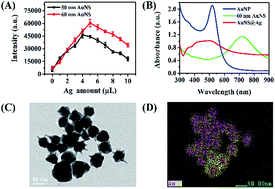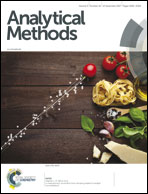Highly sensitive surface-enhanced Raman scattering detection of adenosine triphosphate based on core–satellite assemblies†
Abstract
As an important small molecule, adenosine triphosphate (ATP) plays an important role in the regulation of cell metabolism and supplies energy for various biochemical reactions in organisms. We herein developed a sensitive surface-enhanced Raman scattering (SERS) biosensor for highly specific detection of ATP using core–satellite assemblies. To construct the aptamer-based biosensor, a known ATP binding aptamer was divided into two segments. The first thiol-labeled segment (DNA1) of the aptamer was immobilized on silver-coated gold nanostar (AuNS@Ag) surfaces by an Au–S bond. The second thiol-labeled segment (DNA2) was linked via an Au–S bond to gold nanoparticles (AuNPs), which were also decorated with a Raman active reporter molecule, 4-mercaptobenzoic acid (4-MBA). In the presence of ATP, DNA2 associated with DNA1, leading to greatly enhanced 4-MBA Raman intensity. The enhance Raman signal was linearly related to the logarithm of the ATP concentration in the range from 1 pM to 1 nM, with a detection limit of ∼0.5 pM. In addition, the sensor featured an excellent selectivity to ATP over other interfering analogues of ATP (GTP, CTP, and UTP).



 Please wait while we load your content...
Please wait while we load your content...